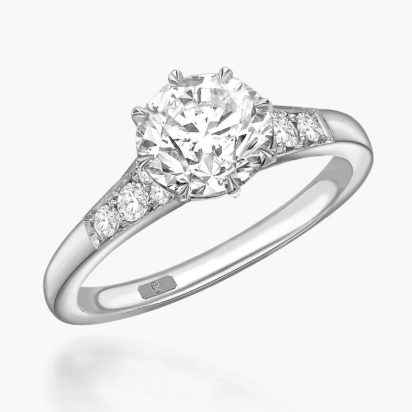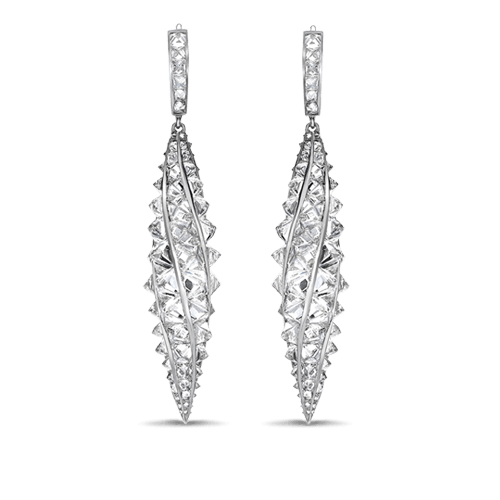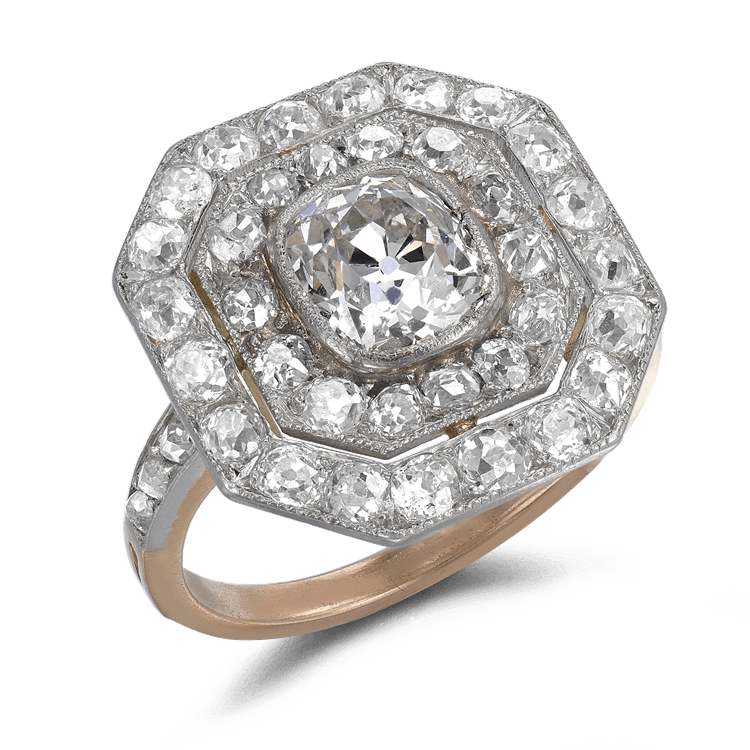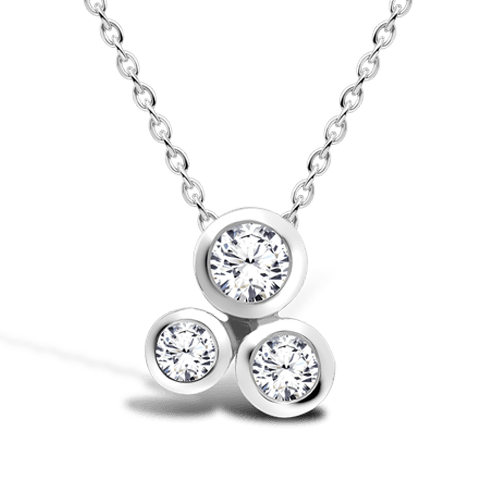The Diamond Carat Guide
Carat weight is one of the esteemed 4Cs of diamond evaluation. In this diamond carat guide, you will discover its significance in shaping a diamond's value, presence, and allure.
.jpg)
What is a Diamond Carat?
A diamond carat (abbreviated as "ct") is a unit of measurement used to express the weight of a diamond. The term "carat" originated from the use of carob tree seeds, which were known for their uniformity in weight and were used in ancient times to balance scales. Early diamond traders would use carob seeds when weighing their diamonds.
One carat is equivalent to 200 milligrams, or 0.2 grams. Carat weight is one of the four key factors, known as the 4Cs (Cut, Colour, Clarity, and Carat Weight), that are used to assess a diamond's quality, value, and appearance.
While carat weight influences a diamond's size, it's important to consider how the carat weight interacts with the other 4Cs to determine a diamond's overall beauty and desirability.
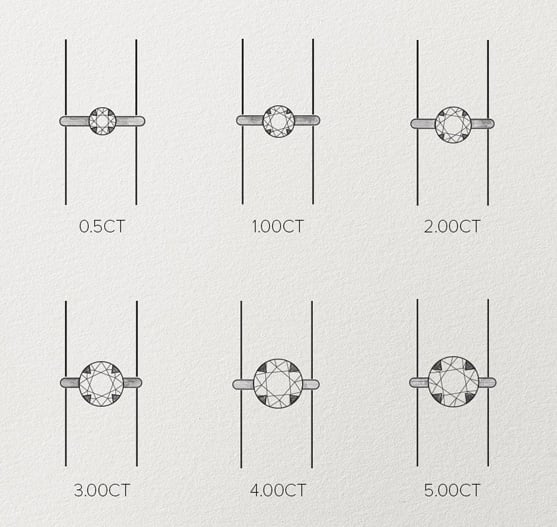
Is a Higher Carat Weight a Better Diamond?
Carat weight isn’t directly related to size or price: a diamond can be cut deeper or shallower, meaning two one-carat stones can have very different proportions. Price is affected by a combination of cut, colour, and clarity, along with the carat weight.
Furthermore, certain carat weights, such as one or two carats, are in greater demand, so their price is disproportionately higher than that of slightly lighter or slightly heavier stones.
Is Diamond Carat the Same as Diamond Size?
Diamond carat and diamond size are related but not the same:
Carat refers to the weight of a diamond and is measured in carats (abbreviated as "ct"). One carat is equal to 200 milligrams. It's a standardised unit of measurement used to quantify the mass of a diamond.
Diamond size, on the other hand, refers to the dimensions of a diamond as it appears from the top view. While carat weight can influence a diamond's size to some extent, it's not the sole determinant.
Factors like the diamond's cut and shape also play a significant role in how large a diamond appears. A well-cut diamond, even if it's slightly lower in carat weight, can actually appear larger because it reflects light optimally and maximises its visual size.
So, while carat weight contributes to a diamond's size, its overall appearance and visual impact are influenced by factors beyond just carat weight, such as cut, shape, and proportion.
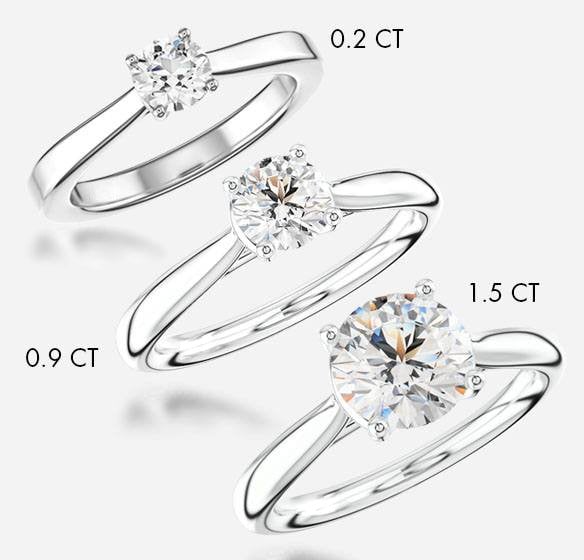
What Size Will My Diamond Be?
A diamond's millimetre measurement tells you its actual size. This is because a diamond of the same carat weight can have slightly different faceting and, therefore, look larger than a carat with the same weight equivalent.
If you want a diamond that looks bigger, consider getting a differently-shaped diamond. Shapes like oval, emerald, and pear often appear larger than their round counterparts of the same weight.
How to Choose a Diamond Carat?
Choosing a diamond carat involves considering personal preferences, budget, and the overall balance of the 4Cs (Cut, Colour, Clarity, and Carat Weight). Here are steps to guide your decision:
Set a Budget: Determine how much you're willing to spend on the diamond. Remember that carat weight significantly affects the price, so finding the right balance is crucial.
Prioritise Carat Weight: Decide how important carat weight is to you. Are you looking for a larger diamond or willing to compromise for other factors like cut and quality?
Consider Finger Size: The size of the diamond should harmonise with the wearer's finger size. A larger diamond might overwhelm smaller hands, while a smaller diamond might not make the desired impact on larger hands.
Balance with Other 4Cs: Remember that the overall beauty of a diamond is influenced by its cut, colour, and clarity. A well-cut diamond will sparkle more and can sometimes appear larger than its carat weight suggests.
Choose a Carat Range: Instead of focusing on a specific carat weight, consider a range that aligns with your budget and preferences. For example, if you're considering a 1-carat diamond, explore options between 0.90 and 1.10 carats.
Explore Shapes:Different diamond shapes can make a diamond appear larger or smaller. Oval, marquise, and pear shapes tend to appear larger, while round brilliants maximise sparkle.
Certification: Ensure the diamond comes with a reputable grading report, verifying its carat weight and other qualities.
Try On Different Sizes: Try on diamonds of various carat weights to see what size appeals to you visually.
Consult Experts: At Pragnell, we can guide you based on your preferences and budget.
Remember that the "right" diamond carat is subjective and depends on individual taste. Finding the ideal balance between carat weight and other qualities ensures that you choose a diamond that resonates with you and fulfils your vision.
Frequently Asked Questions
Below are the answers to our most commonly asked questions. Should you want to find out more please feel free to Contact Us us and begin your Pragnell experience.
View By Category
Explore a selection of pieces from across the Pragnell range
Jewellery CLP Page
Contact us